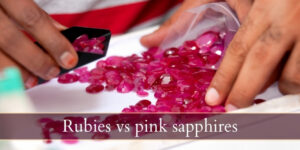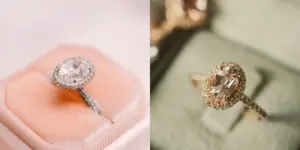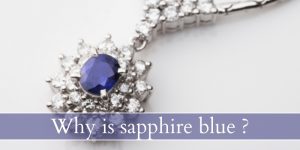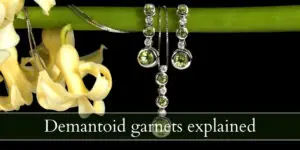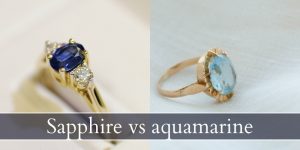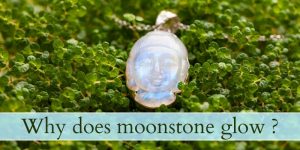Salt and pepper diamonds are not very well know, and have only seen popularity in the past decade or so. Even so, these diamonds have not reached everyone and they’re still a niche product.
By their name you’d expect these diamonds to be unique, and they’re exactly that. Raw and imperfect, that’s just the way these diamonds sparkle. So let’s take a look at what salt and pepper diamonds actually are, and their alternatives if you can’t find any.
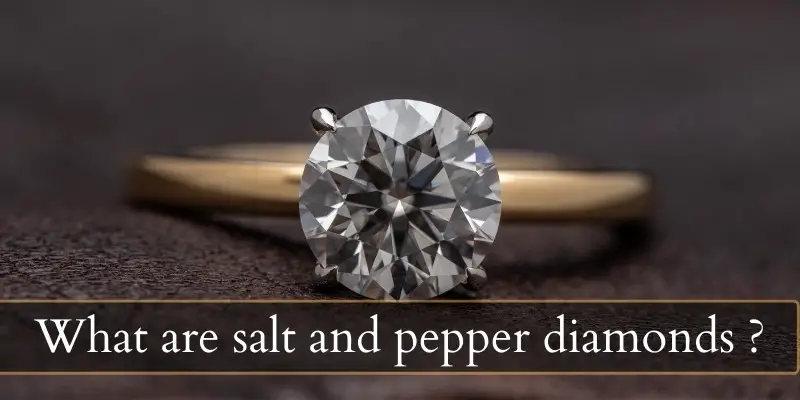
What are salt and pepper diamonds ?
Salt and pepper diamonds are a type of grey diamond. These are diamonds with many inclusions, but the inclusions are large enough to see with the naked eye and they range from black to very light grey. The result is a more or less cloudy diamond with a speckled appearance.
Imperfections are present in all diamonds, though the white, clear diamonds you see on the market have incredibly tiny ones, that may only be seen under a jeweler’s loupe.
Salt and pepper diamonds proudly show off their imperfections, and no two diamonds are the same. Each diamond has its own unique set of inclusions, so all of them are beautiful in their own way. This also makes it hard to choose a specific diamond, but in the end the overall effect is the same.
Because of their imperfections salt and pepper diamonds have significantly less fire and brilliance than a white diamond. That being said, these diamonds definitely achieve a dramatic look, but in a different way.
Read also: What Is Druzy (Druse) ?
Are salt and pepper diamonds less expensive ?
Yes, salt and pepper diamonds are less expensive than regular white diamonds precisely because of the way diamonds are graded. There are four Cs to grading a diamond:
- color – purely white(clear) diamonds are graded the highest
- cut – poorly cut diamonds are graded lower
- clarity – is deeply affected by any inclusions, which may also affect the color
- carat – the size and weight of the diamond
As you’ve noticed, grey diamonds score very low in the color and clarity grades. The very light grey ones with just a few imperfections score a higher grade. That being said, the very nature of a salt and pepper diamond makes it difficult to even care about color and clarity anymore. The whole point of this diamond type is to celebrate the imperfections.
Even so, these diamonds are always graded lower then the classic white diamond, so they will always be more affordable. They are still diamonds, so they won’t be pocket money but they are far less expensive.
Diamonds similar to salt and pepper
Salt and pepper diamonds aren’t a new thing, but rather they’ve never been as popular as they are now. For as long as white diamonds have existed, salt and pepper diamonds have existed as well, but they’ve never really been used. In fact, salt and pepper diamonds have a couple of close siblings.
Grey diamonds
Grey diamonds are the very clear diamonds that somehow do not end up pure white or yellow, instead they have a grey appearance. This is usually due to a multitude of inclusions but they are so small and evenly dispersed that they produce a grey color.
These diamonds are easier to create in a lab so they have a nice, even color. In nature they often have uneven inclusions, so they are classes as salt and pepper most of the time.
Galaxy diamonds
Galaxy diamonds are really a fancy word for a very dark version of a perfectly clear but dark salt and pepper diamond. The effect is very dramatic, leading to a bit of fire in the diamond but with a lot of shadows.
Salt and pepper diamond alternatives
If you love the idea of salt and pepper diamonds, or any sort of grey diamond but simply can’t or don’t want to use it in your jewelry there are various options. Not all of the feature inclusions, like diamonds, because not all of them have carbon impurities. However you can get something fairly similar, for a lower price, depending on what you’re willing to settle for.
Grey spinel
Spinels usually come in a bluish tone, and this also applies to the grey versions. They may veer slightly into purple or they may be perfectly grey, depending on what you find and what grabs your attention the most. These gemstones don’t have inclusions, but they offer a dark grey color and a decent brilliance.
Spinels are 7.5 to 8 on the Mohs scale, so they’re a decent stone that can be set with prongs, but we recommend a bezel setting and a white halo if you’re feeling to going for something extra.
Grey tourmaline
Getting pure grey tourmaline is not easy, but you can get grey-blue ones or you can get one with a slight yellow tint. These stones are 7-7.5 on the Mohs scale so you should definitely set them in a bezel. They can be faceted any way you like.
Grey topaz
Grey topaz has a yellowish hue to it, and it’s a very dark grey, but still not black. This may be a better substitute for galaxy diamond than for salt and pepper, unless you can find a light grey one.
Topaz generally has an 8 rating on the Mohs scale, so it’s reasonably rough but may still scratch here and there. If it’s not for everyday wear it may have a prong setting, but it may chip and scratch if work daily for decades.
Grey quartz
Grey quartz is one of the easiest alternatives to salt and pepper diamonds, because it has a similar set of imperfections. Where salt and pepper diamonds generally have dark inclusions, grey quartz has tiny white fractures and inclusions, so the overall effects is similar.
Keep in mind that quartz has a 7 on the Mohs scale, so it’s not the most durable stone out there.
Cubic zirconia or moissanite
If you cannot find anything you like, take a look at some cubic zirconia or moissanite. These gemstones are lab-grown, yes, but the upside is that they can easily achieve the look you’re going for if you ask your jeweler to source them for you.

I’m the main author for jewelrymaterialguide.com. I started this site after we did tons of research before our wedding and noticed that there is information about rings, jewelry, and so on that is really hard to find on the internet.

